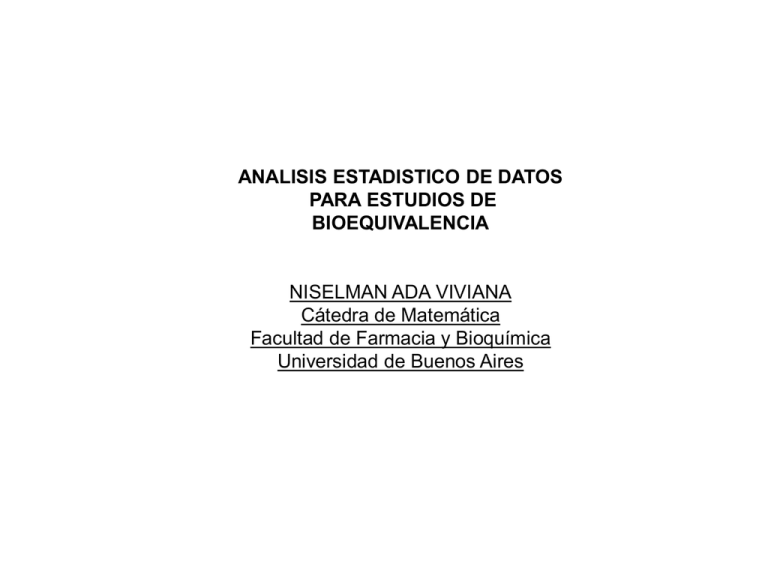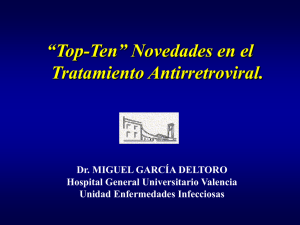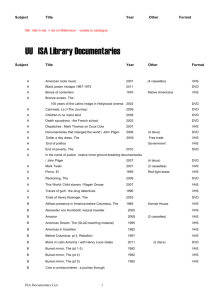Diapositiva 1 - Facultad de Ingeniería
advertisement

ANALISIS ESTADISTICO DE DATOS
PARA ESTUDIOS DE
BIOEQUIVALENCIA
NISELMAN ADA VIVIANA
Cátedra de Matemática
Facultad de Farmacia y Bioquímica
Universidad de Buenos Aires
Número de voluntarios
El número de voluntarios de un estudio de bioequivalencia deberá ser calculado
teniendo en cuenta la Variabilidad Intraindividual,
la Máxima diferencia a ser detectada (20%; 0,20)
y los errores de Tipo I (Alfa =0,05) y Tipo II (Beta=0,20).
El cálculo del número de voluntarios,
deberá figurar en el protocolo, así como la fórmula utilizada para su
cálculo y las asunciones estadísticas.
el tamaño total de muestra N , se podrá
calcular de acuerdo a la siguiente fórmula
propuesta por Marzo y Balant (1995):
N > 15,68 x CV intraindividual2 / Δ2
Donde:
CV es el Coeficiente de Variación
Intraindividual
Δ2 = 0,202 = 0,04.
Análisis estadístico
La metodología estadística deberá estar expresada en
el protocolo
en el informe final
estableciendo los “límites de riesgo”
de declarar falsamente
la bioequivalencia entre dos productos.
En la metodología se debe incluir
estadística descriptiva
estadística inferencial.
Análisis estadístico
La metodología estadística deberá estar expresada en
el protocolo
en el informe final
estableciendo los “límites de riesgo”
de declarar falsamente
la bioequivalencia entre dos productos.
En la metodología se debe incluir
estadística descriptiva
estadística inferencial.
Estadística descriptiva
1.2. - Para cada individuo:
a) Unidad de medida.
b) Valores en cada tiempo.
c) Secuencia.
d) Producto recibido (Test o Ref).
- Para cada concentración/tiempo:
a) Media aritmética .
b) Mediana.
c) Desvío estándar.
d) Coeficiente de Variación por ciento (CV%).
e) Valor mínimo (Mn).
f) 1° cuartilo.
g) 3° cuartilo
h) Valor máximo.(Mx).
Gráficos Exigidos
1) concentración/tiempo
de cada voluntario con
las formulaciones
Test y Referencia
(dos gráficos por voluntario).
2) Estas figuras se presentarán
con los datos no transformados
logarítmicamente.
3) una figura resumen con los datos promedio
(no transformados logarítmicamente)
de cada tiempo (“Curvas resumen”).
4) Se deberán presentar todos
los datos, incluso los de aquellos voluntarios
que hayan abandonado el estudio
o representen valores extremos o atípicos.
e) Concentración máxima
(Cmáx).
f) Tiempo en alcanzar
Cmáx. (Tmáx).
g) Constante de
eliminación (ke).
h) Vida media (T½).
i) Área bajo la curva a
tiempo t (AUCt)
j) Área bajo la curva a
infinito (AUCinf).
. Tabla de la Secuencia para cada voluntario y
cada tratamiento con:
a) Cmáx.
b) Tmáx.
c) Ke.
d) T½.
e) AUC0-t.
f) AUCinf.
Para cada uno de los parámetros, expresar:
• Media aritmética (Md).
• Mediana (Mn).
• Media geométrica (MG).
• Desvío estándar.
• Coeficiente de Variación por ciento (CV%).
• Valor mínimo (Mn).
• 1° cuartilo.
• 3° cuartilo
• Valor máximo.(Mx).
Criterio de BE actual
T
0.80
1.25
R
Diseño ross-over 2x2
Transformación logaritmo
IC al 90% para GMR
contenido en (0.80,1.25)
Análisis de Variancia (ANOVA)
ANOVA de los (ln) de (Cmáx,
AUC0-t y AUCInf).
Se presentará la tabla del ANOVA
de cada uno de los parámetros
Especificando las fuentes de variación
(Secuencia/arrastre, Período, Tratamiento),
grados de libertad,
suma de cuadrados,
cuadrados medios,
valor del estadístico F y
los valores correspondientes de p.
Análisis de Variancia (ANOVA)
La Hipótesis Nula a testear con el ANOVA
es:
H0: μ T = μ R
CMAX
IN
D
Period
1
Period
2
Seq
A
TR
122
126
B
RT
207
102
C
RT
123
202
E
TR
59
37
F
RT
85
66
G
TR
54
55
H
RT
219
101
I
TR
90
182
K
RT
60
155
L
TR
57
26
M
TR
23
57
N
RT
47
38
O
RT
71
43
P
TR
68
97
Q
RT
88
28
R
TR
99
60
Analysis of variance table: CMAX
df
SS
MS
F
PValue
Carry-over
1
0.5464
0.5464
1.0373
0.3257
Residuals
14
7.3738
0.5267
2.5147
0.0478
Drug
1
0.1821
0.1821
0.8694
0.3669
Period
1
0.1109
0.1109
0.5293
0.4789
Residuals
14
2.9323
0.2095
Total
31
11.145
4
InterSubjects
IntraSubjects
AUCt
I
D
Period
1
Perio
d2
Seq
A
TR
365
375
B
RT
405
595
C
RT
703
471
E
TR
233
190
F
RT
247
257
G
TR
178
175
H
RT
246
382
I
TR
408
361
K
RT
315
218
L
TR
140
92
M
TR
165
269
N
RT
88
106
O
RT
183
290
P
TR
122
230
Q
RT
68
144
R
TR
275
344
Analysis of variance table: AUCt
df
SS
MS
F
PValue
Carryover
1
0.054
0.054
0.090
0.767
Residuals
14
8.426
0.601
8.226
0.002
Drug
1
0.024
0.024
0.332
0.573
Period
1
0.138
0.138
1.889
0.190
Residuals
14
1.024
0.073
Total
31
9.667
InterSubjects
IntraSubjects
La Tabla modelo de análisis de variancia:
debe especificará el CV Intraindividual %,
Con datos log-transformados
puede
calcularse
con la siguiente formula:
CV MSE 100
Ejemplo de Cálculo del CV
La raiz cuadrada del Cuadrado Medio
del Error Residual
estima el Coeficiente de Variación Intra
–Sujeto.
CV
CMres
0.0731 0.27
AUCinf
Peri
od1
Period
2
ID
Seq
A
TR
409
418
B
RT
613
432
C
RT
492
774
E
TR
256
224
F
RT
285
265
G
TR
205
190
H
RT
398
263
I
TR
433
406
K
RT
236
372
L
TR
331
105
M
TR
195
327
N
RT
125
113
O
RT
313
215
P
TR
148
266
Q
RT
156
113
R
TR
292
369
df
SS
MS
F
PValue
Analysis of variance table: AUCinf
Inter-Subjects
Seq o Carryover
1
0.0120
0.0120
0.0273
0.8711
Suj dentro de
Seq o
Residuals
14
6.1520
0.4394
4.2245
0.0054
Drug
1
0.0138
0.0138
0.1328
0.7210
Period
1
0.0195
0.0195
0.1879
0.6713
Residuals
14
1.4563
0.1040
Total
31
7.6537
Intra-Subjects
In which cases may a non-parametric statistical model be used?
Statistical analysis: “AUC and Cmax should be analysed using ANOVA after
log transformation.”
The reasons for this request are the following:
a) the AUC and Cmax values as biological parameters are usually not normally
distributed;
c) after log transformation the distribution may allow a parametric analysis.
d) due to the small sample size, is not recommended pre-test for normality.
e) Parametric testing using ANOVA on log-transformed data should be the rule.
f) For tmax, the use of non-parametric methods on the original data set is
recommended.
TMAX
IND
Seq
Period1
P2
A
TR
1,5
1,5
B
RT
1,5
1,5
C
RT
1,5
0,6
E
TR
3
1
F
RT
2
1
G
TR
1,5
1,5
H
RT
1
1
I
TR
1,5
0,6
K
RT
1,5
1,5
L
TR
1
2
M
TR
4
1,5
N
RT
0,6
0,6
O
RT
1,5
1
P
TR
0,6
1,5
Q
RT
1,5
1,5
R
TR
2
2
INTERVALO DE CONFIANZA
- Relación T/R (Punto Estimado)
y su intervalo de confianza 90%.
Se expresará para cada parámetro (Cmáx, AUC0-t y
AUCinf),
la razón T/R (Punto Estimado) y
el intervalo de confianza 90% de la misma.
Classical (shortest) IC: CMAX
Confidence
Bounds
Observed
Within Equivalence
Limits?
Lower [10.00]% Conf.
limit
0.6918
No
Upper [10.00]% Conf.
limit
1.0690
Yes
Antilogged point estimate =0.86 00
Classical (shortest) Confidence Interval:
AUCt
Confidence
Bounds
Observe
d
Within
Equivalence
Limits?
Lower [10.00]%
Conf. limit
0.9291
Yes
Upper [10.00]%
Conf. limit
1.2017
Yes
Antilogged point
estimate = 1.0567
Classical (shortest) Confidence Interval: AUCinf
Confidence Bounds
Observed
Within Equivalence
Limits?
Lower [10.00]% Conf. limit
0.8229
Yes
Upper [10.00]% Conf. limit
1.1183
Yes
Antilogged point estimate = 0.9593
Parámet
ro
Geo
Mean
Media
Test
Ratio
estima
do
IC
Cmax
80.89
69.56
0.86
0.69-1.06
AUCt
276.97
265.70
1.05
0.93-1.20
AUCinf
227.80
240.71
0.96
0.82-1.11
Test de la hipótesis intervalar
Anderson Hauck
T
H0 )
0.80
R
H0 )
o
T
1.25
R
T
0.80
1.25
R
Test de 2 las hipótesis unilaterales
Schuirmann
H 01 )T / R0.80
H 02 )T / R1.25
H 11 )T / R>0.80
H 12 )T / R<1.25
Schuirmann:
CMAX
t-Value
One-sided p-value to
reject non-
equivalence
Observed
Specified
Observed
Specified
Null Hypothesis L
t-statistic
1.7613
0.4467
0.0500
0.3310
Null Hypothesis U
t-statistic
-1.7613
-2.3115
0.0500
0.0183
Schuirmann AUCt
t-Value
One-sided p-value to
reject non-equivalence
Observed
Specifie
d
Observe
d
Specified
Null
Hypothesis L tstatistic
1.7613
2.9100
0.0500
0.0057
Null
Hypothesis U tstatistic
-1.7613
-1.7568
0.0500
0.0504
Schuirmann AUCinf
t-Value
One-sided p-value to
reject non-equivalence
Observed
Specified
Observed
Specified
Null
Hypothesis L tstatistic
1.7613
1.5925
0.0500
0.0668
Null
Hypothesis U tstatistic
-1.7613
-2.3213
0.0500
0.0179
Conclusión Preliminar
AUCt y AUCinf satisfacen la cond de BE.
Cmax no la cumple con límites 0.80/1.25
Cmax la cumple con límites 0.70/1.33
Country/Region
AUC 90% CI
Criteria
Canada (most drugs)
80 – 125%
Cmax 90% CI
Criteria
none
(point
estimate only)
Europe (some drugs)
80 – 125%
75 – 133%
South Africa (most
drugs)
80 – 125%
75 – 133% (or broader if justified)
Japan (some drugs)
80 – 125%
Some drugs wider than 80 – 125%
Worldwide (WHO)
80 – 125%
“acceptance range for Cmax may
be wider than for AUC”
Criterios de aceptación de bioequivalencia
Wilcoxon-Mann-Whitney TMAX
Null Hypothesis L: Mean T- Mean R <= Lower Bound
Null Hypothesis U: Mean T- Mean R >= Upper Bound
Rank Sums
Observed
Specified
Null
Hypothesis L
test statistic
48.0000
42.0000
Null
Hypothesis U
test statistic
16.0000
21.0000
Hodges-Lehmann Interval: TMAX
Hodges-Lehmann estimate (median of all possible pairwise differences) = 0.0000
Confidence Bounds
Specifie
d
Observe
d
Within
Equivalence
Limits?
Lower [5.00]%
Conf. limit
-0.2853
-0.4200
No
Upper [5.00]%
Conf. limit
0.2853
0.5000
No
Suj
Seq
Period1
Period2
T/R
B
RT
207
102
0,49275362
C
RT
123
202
1,64227642
F
RT
85
66
0,77647059
H
RT
219
101
0,46118721
K
RT
60
155
2,58333333
N
RT
47
38
0,80851064
O
RT
71
43
0,6056338
Q
RT
88
28
0,31818182
A
TR
122
126
0,96825397
E
TR
59
37
1,59459459
G
TR
54
55
0,98181818
I
TR
90
182
0,49450549
L
TR
57
26
2,19230769
P
TR
68
97
0,70103093
R
TR
99
60
1,65
Media
1,08472389
Desvio
0,68714366
2desvios
1,37428732
Med+/-2 desv
-0,28956344
2,06143098
Bioavailability is defined as the rate and
extent to which the active drug
ingredient is absorbed and becomes
available at the site of drug action
Two drug products are said to be
bioequivalent if they are
pharmaceutical equivalent or
pharmaceutical alternatives, and if
their rates and extents of
absorption do not show a
significant difference.
Fundamental Bioequivalence Assumption
When a generic drug is claimed bioequivalent to a brandname drug, it is assumed that they are
therapeutically equivalent.
Bioequivalence is claimed if the ratio of
average bioavailabilities between test
and reference products is within (80%,
125%) with 90% assurance (logtransformed data).
Confidence Interval
The classical (shortest) confidence interval
Interval Hypotheses Testing
Shuirmann’s two one-sided tests procedure
FDA guidance on Statistical
Approaches to Establishing
Bioequivalence
(January, 2001)
FDA guidance on Bioavailability
and Bioequivalence Studies for
Orally Administered Drug
Products – General Considerations
(July, 2002)
Most regulatory agencies including the
U.S. Food and Drug Administration
(FDA) require evidence of
bioequivalence in average
bioavailabilities between drug products.
This type of bioequivalence is
referred to as ABE.
Based on the 2001 FDA guidance,
bioequivalence may be established via
population and individual
bioequivalence provided that the
observed ratio of geometric means is
within the bioequivalence limits of 80%
and 125%.
A generic drug can be used as a
substitute for the brand-name drug if it
has been shown to be bioequivalent to
the brand-name drug.
Current regulations do not indicate that
two generic copies of the same brandname drug can be used interchangeably,
even though they are bioequivalent to
the same brand-name drug.
Bioequivalence between generic copies
of a brand-name drug is not required.
Generic Drugs
They’re cheaper, but do they work as
well?
Average Bioequivalence (ABE)
Current regulatory requirement
Population Bioequivalence (PBE)
Prescribability
Individual Bioequivalence (IBE)
Switchability
Aggregate criterion
Moment-based approach
Scaling method
Weighing factors
One-sided test
Drug Prescribability
Brand-name vs. its generic copies
Generic copies vs. generic copies
Drug Switchability
Brand-name vs. its generic copies
Generic copies vs. generic copies
Current regulation for ABE does not
guarantee drug prescribability and drug
switchability
Population Bioequivalence (PBE)
Anderson and Hauck (1990)
Chow and Liu (1992)
The physician’s choice for prescribing
an appropriate drug for his/her patients
between the brand-name drug and its
generic copies
General Approaches for IBE/PBE
is a measure of the relative difference between the
mean squared errors of yR- yT and yR - yR'
E ( yR yR' )2 2 is the within-subject variance of the
reference formulation
2
2
( T R ) 2 TT
TR
2
max{ 02 , TR
}
for PBE
2
2
( T R ) 2 D2 ( WT
WR
)
for IBE
2
2
max{ 0 , WR }
Individual Bioequivalence (IBE)
Anderson and Hauck (1990)
Schall and Luus (1993)
Holder and Hsuan (1993)
Esinhart and Chinchilli (1994)
The switch from a drug (e.g., a brandname drug or its generic copies) to
another (e.g., a generic copy) within the
same patient whose concentration of
the drug has been titrated to a steady,
efficacious and safe level
Notations
mT = mean of the test product
mR = mean of the reference product
sWT2 = within-subject variability for
the test product
sWR2 = within-subject variability for
the reference product
sD2 = variability due to the subjectby-formulation interaction
IBE Criterion
( T R ) (
2
max( , W 0 )
2
Where
I
2
D
2
WR
2
WT
(ln1.25)
2
2
W0
2
WR
)
I
General Approaches for IBE/PBE
is a measure of the relative difference between the
mean squared errors of yR- yT and yR - yR'
E ( yR yR' )2 2 is the within-subject variance of the
reference formulation
2
2
( T R ) 2 TT
TR
2
max{ 02 , TR
}
for PBE
2
2
( T R ) 2 D2 ( WT
WR
)
for IBE
2
2
max{ 0 , WR }
Assessment of IBE
Hypotheses Testing
H 0 : IBE versus H 0 : IBE
IBE is claimed if a 95% confidence upper bound of is
less than IBE and the observed ratio of geometric means
is within bioequivalence limits of 80% and 125%.
References
1. FDA (1999). In Vivo Bioequivalence Studies Based on Population and Individual
Bioequivalence Approaches. Food and Drug Administration, Rockville, Maryland,
August, 1999.
2. FDA (2001). Guidance for Industry: Statistical Approaches to Establishing
Bioequivalence. Food and Drug Administration, Rockville, Maryland, January, 2001.
Special Issues
Chow, S.C. (Ed.) Special issue on Bioavailability and
Bioequivalence of Drug Information Journal, Vol. 29, No.
3, 1995
Chow, S.C. (Ed.) Special issue on Bioavailability and
Bioequivalence of Journal of Biopharmaceutical
Statistics, Vol. 7, No. 1, 1997
Chow, S.C. and Liu, J.P. (Ed.) Special issue on
Individual Bioequivalence of Statistics in Medicine, Vol.
19, No. 20, October, 2000.
Review of FDA Guidances
Chow, S. C. and Liu, J. P. (1994). Recent statistical
development in bioequivalence trials - a review of FDA
guidance. Drug Information Journal, 28, 851-864.
Liu, J. P. and Chow, S. C. (1996). Statistical issues on
FDA conjugated estrogen tablets guideline. Drug
Information Journal, 30, 881-889.
Chow, S. C. (1999). Individual bioequivalence - a
review of FDA draft guidance. Drug Information
Journal, 33, 435-444.
Wang, H., Shao, J., and Chow, S.C. (2001). On FDA’s
statistical approach to establishing population
bioequivalence. Unpublished manuscript.
Books
Chow, S.C. and Liu, J.P. (1998). Design and Analysis of
Bioavailability and Bioequivalence Studies, 2nd edition,
Marcel Dekker, New York, New York.
Chow, S.C. and Shao, J. (2002). Statistics in Drug
Research, Marcel Dekker, New York, New York.
Chow, S.C., Shao, J., and Wang, H. (2003). Sample
Size Calculation in Clinical Research, Marcel Dekker,
Inc., New York, New York.
Original Articles
Shao, J., Chow, S. C., and Wang, B. (2000). Bootstrap
methods for individual bioequivalence. Statistics in
Medicine, 19, 2741-2754.
Chow, S.C., Shao, J., and Wang, H. (2002). Individual
bioequivalence testing under 2x3 crossover designs.
Statistics in Medicine, 21, 629-648.
Chow, S.C. and Shao, J. (2002). In vitro bioequivalence
testing. Statistics in Medicine, 22, 55-68 .
Chow, S.C., Shao, J., and Wang, H. (2003). Statistical
tests for population bioequivalence. Statistica Sinica, 13,
539-554.
OBJETIVO
a) Discernir entre formulaciones
b) Evaluar el efecto producido en la disolución
por los cambios en las variables del proceso de manufactura
aseguramiento de la calidad
uniformidad de lote a lote
¿cómo cuantificar el grado de similitud
o diferencia entre dos curvas?
FDA. Center for Drug Evaluation and Research,
Guidance for Industry:
Modified Release Solid Oral Dosage Forms.
Scale-up and Post-Approval Changes:
Chemistry, Manufacturing and Controls
In Vitro, and In Vivo Bioequivalence Documentation
[SUPAC- MR ]; 1997
FDA. CDER
Guidance for
Industry
Dissolution Testing
of
Immediate Release
Solid Oral Dosage
Forms.
[SUPAC-IR]; 1997
METODO MODELO NO DEPENDIENTE,
EMPLEANDO LOS FACTORES DE AJUSTE.
Jeffrey W. Moore et al (1996)
Se compara la diferencia en el % disuelto
por unidad de tiempo entre referencia y prueba.
Estos factores son
f1 (factor de diferenciación)
f2 (factor de similitud) :
Un valor f2 menor de 50
no indica necesariamente falta de similitud.
Si el patrocinador opina que las diferencias
en f2 son típicas para el producto
se puede presentar la justificación apropiada
Como suplemento de aprobación previa.
Esta justificación deberá incluir
análisis estadísticos de respaldo
(p.ej., un análisis de intervalo de confianza del 90%).


